Summer Hill, New South Wales
| Summer Hill Sydney, New South Wales | |||||||||||||||
|---|---|---|---|---|---|---|---|---|---|---|---|---|---|---|---|
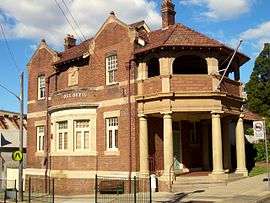 The former Summer Hill Post Office, Smith Street, is heritage-listed[1] | |||||||||||||||
| Population | 7,311 (2016 census)[2] | ||||||||||||||
| • Density | 6,650/km2 (17,200/sq mi) | ||||||||||||||
| Postcode(s) | 2130 | ||||||||||||||
| Area | 1.1 km2 (0.4 sq mi) | ||||||||||||||
| Location | 7 km (4 mi) west of Sydney CBD | ||||||||||||||
| LGA(s) | Inner West Council | ||||||||||||||
| State electorate(s) | Summer Hill | ||||||||||||||
| Federal Division(s) | Grayndler | ||||||||||||||
| |||||||||||||||
Summer Hill is a suburb of Sydney, in the state of New South Wales, Australia. Summer Hill is located 7 kilometres west of the Sydney central business district, in the local government area of the Inner West Council.
Summer Hill is a primarily residential suburb of Sydney's Inner West, adjoining two of Sydney's major arterial roads, Parramatta Road and Liverpool Road. The first land grant was made in 1794 to former convict and jailor Henry Kable, and the suburb began growing following the opening of the railway station on the Main Suburban railway line, in 1879.
By the 1920s, the suburb had become relatively upper class, with large estates and mansions built throughout the suburb. Some of these still exist today. Following a transition to a working-class suburb in the mid-20th century, when many of the large estates were demolished or subdivided, the suburb today has a "village" character and a mix of medium-density apartment blocks and federation houses.
Characteristics
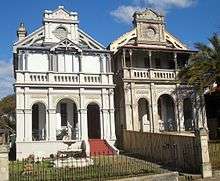
Summer Hill's boundaries are Parramatta Road and Liverpool Road to the north, the rear of the properties on the west side of Prospect Road (with a detour around Trinity Grammar School) to the West, Old Canterbury Road to the south, and the Inner West Light Rail to the east. North of Summer Hill is the suburb of Haberfield, to the east is Lewisham, to the south is Dulwich Hill, and to the west is Ashfield.[3]
Summer Hill has a mix of Federation-era houses, with medium density apartment blocks near the railway station. Local independent business people run most of the shops. The local council has defined a village character for the suburb.[4] Summer Hill is a suburb rich in heritage. More than one hundred properties are heritage listed, and the strong feelings of some residents of the suburb towards protecting the local architecture has seen the introduction of a heritage review, which is expected to add more properties to the heritage register.[5]
Despite formerly being working class, Summer Hill and many of the surrounding suburbs have gradually undergone gentrification over recent years. Culturally, Summer Hill is a blend of medium-density European Sydney suburbia, with Italian influences (which are most evident in Leichhardt to the east and Haberfield to the north), Asian (mainly Chinese) influences (which are most strongly evident in Ashfield to the West), and smaller influences from many other cultures.[6]
History
Aboriginal Anthropology
Before the First Fleet arrived at Port Jackson in 1788, what is now known as Summer Hill was part of a larger area where people of the Wangal and Cadigal nations lived. There is research to show in the greater Sydney region 8000 - 10000 Aboriginal people were resident, fluctuating on seasons and during tribal conflicts.[7] What is now called the Hawthorne Canal (originally Long Cove Creek) appears to have been the boundary between the Cadigal and Wangal Aboriginal nations. Today there is a small park in Summer Hill, called Cadigal Reserve, located at 1-4 Grosvenor Crescent. A bronze plaque placed by Ashfield Council names the reserve after the Cadigal (Eora) group of Koori people.[8] Iron Cove and the mangrove-lined estuaries of the Long Cove and Iron Cove Creeks would have provided a good source of fish and molluscs, the most common food of the coastal tribes in the Sydney basin.[7]
In the early days of the colony, the land between Iron Cove and the Cooks River was known as the Kangaroo Ground.[7] This suggests that the land was open terrain favoured by kangaroos, that they were common in the area and may have formed a significant part of the Aboriginal diet.[7]
European settlement
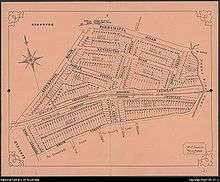

The first land grant in this area was for a farm in 1794, to former convict and jailor Henry Kable. The land in the eastern corner of Summer Hill was an additional grant of 30 acres (12 ha) made to Henry Kable in 1804. This eastern corner would subsequently become part of the estate of James Underwood. Underwood died in 1844 and left a will so complicated that it required special legislation before it could be subdivided.[6]
The earliest known use of the name "Summer Hill" was in 1876, for a land subdivision adjacent to the present-day St Andrew's Anglican Church. The name Summer Hill is thought to be a name chosen by the land sub-divider, presumably based on an attachment for England. Local historians regard the suggestion that the name is a derivation of "Sunning Hill" as a dubious story which has no substance.[6]
Summer Hill's largest mansion, Carleton (now the Grosvenor Hospital's main building), was built in the early 1880s on Liverpool Road for Charles Carleton Skarrat. The suburb boomed with the opening of the railway station in 1879, and was followed by subdivision of much of the surrounding area. Between 1880 and 1910, the area became an upper-class suburb, and was a popular choice for professionals in banking and insurance who worked in the city.[6] Subdivision of gardens for housing continued in the 1920s and 1930s, and socioeconomically the suburb changed as some of the wealthier inhabitants moved to the North Shore. Demolition of most of the surviving mansions in the 1970s allowed erection of home units, especially within walking distance of the railway station.[6]
Churches and other places of worship
St_Patricks_Church_Summer_Hill-1.jpg)
There are a number of places of worship in Summer Hill. St Patrick's Catholic Church was built in 1874, and is the oldest known building in the suburb. There is also a small primary school associated with the church and located next to it.
The building was originally a private home known as Kelvin Grove, and owned by Mrs Jane Drynan. Much of the exterior of the church is original but none of the internal walls were retained when the building was converted into a church. Following Drynan's death, Kelvin Grove was owned or leased by a succession of different people, including the Haberfield real-estate developer Richard Stanton, Croydon brick-maker William Downton, and two sisters named Freeman (one of whom was a nurse). In the 1920s and 1930s Kelvin Grove may have been used as a nursing home. The first mass was celebrated in Kelvin Grove on St Patrick's day 1946, giving the church its name.[6]
St Andrew's Anglican Church has three distinctive internal transept arches, and was designed by a Presbyterian, Alexander Leckie Elphinstone Junior. The foundation stone was laid in 1883, and the top of the spire completed in 1906. The fast construction period, unusual for that time, was indicative of the area's affluence. Recent Asian influences in Summer Hill have brought about the introduction of non-Christian places of worship. The Wong Tai Sin (or Kwan Yin Kur) temple is located on the corners of Kensington Road and Liverpool Road in a building that was a Masonic temple in the 1920s.[6] The same building was converted into the current temple; the lower floor houses the Taoist deity of Wong Tai Sin, and the upper floor houses the Buddhist Bodhisattva of Kwan Yin.
Schools
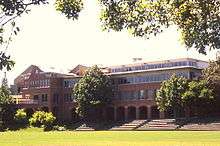
Trinity Grammar School in Prospect Road is a private school catering for students from PreK to Year 12. The schools's site has been in continuous use for education for 120 years. The headmaster's house at Trinity was erected circa 1877. The site operated as several different teaching institutions until it was purchased by the Anglican Church, becoming known as Trinity Grammar School in 1925.[6] Trinity Grammar is one of many wealthy schools in New South Wales, and has previously received some of the largest government subsidies, when comparing total government subsidies per school.[9][10] An expansion plan by Trinity involving the demolition of houses in nearby Seaview Street caused controversy in 2007. The development was nonetheless approved by the New South Wales Land and Environment Court.[11]
Summer Hill Public School, located in Moonbie Street, is a primary school that caters for students from Kindergarten to Year 6. It offers a selective program, known as Opportunity Classes, for Year 5 and 6 students under the New South Wales Government's Opportunity Class program. The school was established in 1883 in a wooden shed on 2 acres (8,100 m2) of land that had been resumed from James Bartlett. The older buildings currently used at the school date back to 1913 while more modern buildings were constructed in 1977, 1998 and 2010. The school, designed in the Victorian Classical style, is listed on the Register of the National Estate.[12]
Saint Patrick's Catholic School is a private primary school, close to Summer Hill Public School.
Commercial area
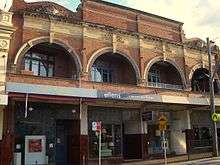
Summer Hill's shopping precinct is centred around a small town square with good pedestrian access, and is surrounded by cafés and restaurants along Lackey and Smith Streets. The suburb is very small by Australian standards, having a population of just over 6000, in an area of 110 hectares. It features some fine examples of architecture from the 19th and early 20th century.[13]
The Summer Hill flour mill was built circa 1922, utilising the north-south goods railway line that was constructed during World War 1. The silos were added from the 1950s onwards. The flour mill has been owned by various companies, including Mungo Scott, Allied Flour & Starch and Goodman Fielder, and then Allied Mills.[6] In October 2007, the mills were sold to a developer, EG Funds Management, who plans to redevelop the mill site into a residential and commercial precinct.[14]
Transport
In the 2011 census, for people travelling to work from this suburb, 34% travelled in a car as the driver, 34% took the train, 5% walked, 4% took the bus and train and 3% took the bus.[2] Summer Hill is close to the main thoroughfares of Liverpool Road and Parramatta Road; although they are quite congested at peak times.
From 1915, Summer Hill was served by trams from Hurlstone Park. Trams left New Canterbury Road and went down Prospect Road, then swung right onto Smith Street. They turned onto Lackey Street, where they went right and terminated at the station. Low usage and rival buses saw the line closed in 1933, however some remains can be seen.
Summer Hill railway station is located on the Airport, Inner West & South Line of the Sydney Trains network. The railway station was opened on 15 September 1879,[15] and most of the local shops are clustered close to the station. Travelling towards the city, the railway stops in order are Lewisham, Petersham, Stanmore, Newtown, Macdonaldtown, Redfern, Central, and Town Hall. Travelling west towards Strathfield, the stops are Ashfield, Croydon, Burwood, Strathfield and Homebush. A renovation and easy access upgrade of the railway station was completed in 2004.
There are two stations serving Summer Hill on the Dulwich Hill Line of Sydney's light rail network. These are - Lewisham West (adjacent to the former flour mill on the border with Lewisham) and Taverners Hill (near Parramatta Road). Access to the city is quicker by train, but the light rail may be used for some cross-regional journeys. It also interchanges with Dulwich Hill railway station on the Bankstown Line.
There are four Sydney Buses routes that service the area—the 480 and 483 follow routes along Parramatta Road and then Liverpool Road, the 461 travels along Parramatta Road and the 413 travels along Junction Road.
The area is also gradually becoming more bicycle friendly, with several bicycle paths in the suburb.[16] A local group, "Friends of the Greenway" wish to see a bicycle and walking corridor built alongside the light rail.[14]
Climate
The nearest site to Summer Hill is the Canterbury Racecourse AWS which is located several km's to the South West of Summer Hill town centre.
| Climate data for Canterbury Racecourse AWS (Data from 1995 - 2017) | |||||||||||||
|---|---|---|---|---|---|---|---|---|---|---|---|---|---|
| Month | Jan | Feb | Mar | Apr | May | Jun | Jul | Aug | Sep | Oct | Nov | Dec | Year |
| Record high °C (°F) | 44.6 (112.3) |
43.1 (109.6) |
39.0 (102.2) |
34.5 (94.1) |
28.0 (82.4) |
25.6 (78.1) |
25.5 (77.9) |
29.0 (84.2) |
34.7 (94.5) |
37.3 (99.1) |
40.9 (105.6) |
40.3 (104.5) |
44.6 (112.3) |
| Average high °C (°F) | 27.8 (82) |
27.3 (81.1) |
26.0 (78.8) |
23.4 (74.1) |
20.6 (69.1) |
18.1 (64.6) |
17.5 (63.5) |
19.0 (66.2) |
21.9 (71.4) |
23.5 (74.3) |
24.8 (76.6) |
26.5 (79.7) |
23.0 (73.4) |
| Average low °C (°F) | 18.4 (65.1) |
18.3 (64.9) |
16.6 (61.9) |
12.8 (55) |
9.3 (48.7) |
7.2 (45) |
5.8 (42.4) |
6.5 (43.7) |
9.5 (49.1) |
12.1 (53.8) |
14.9 (58.8) |
16.8 (62.2) |
12.4 (54.3) |
| Record low °C (°F) | 10.3 (50.5) |
11.1 (52) |
6.9 (44.4) |
2.4 (36.3) |
1.5 (34.7) |
−0.9 (30.4) |
−1.6 (29.1) |
0.3 (32.5) |
2.7 (36.9) |
4.4 (39.9) |
6.5 (43.7) |
8.5 (47.3) |
−1.6 (29.1) |
| Average rainfall mm (inches) | 83.5 (3.287) |
102.3 (4.028) |
74.6 (2.937) |
109.3 (4.303) |
78.1 (3.075) |
108.2 (4.26) |
59.5 (2.343) |
66.8 (2.63) |
46.8 (1.843) |
59.0 (2.323) |
78.7 (3.098) |
64.8 (2.551) |
970.9 (38.224) |
| Average precipitation days | 11.2 | 11.3 | 12.1 | 11.5 | 11.2 | 12.5 | 11.2 | 8.0 | 8.0 | 8.5 | 11.7 | 10.4 | 128.0 |
| Average afternoon relative humidity (%) | 57 | 60 | 58 | 57 | 54 | 54 | 50 | 42 | 46 | 50 | 54 | 54 | 53 |
| Source: Bureau of Meteorology[17] | |||||||||||||
Population
Demographics


In the 2016 census, the population of the Summer Hill was 7,311, in an area of 1.1 square kilometres. The population was 51.4% females, 48.6% males. 41.7% of the population was born overseas with China (4.8%), England (3.6%), New Zealand (2.2%), Philippines (2.2%) and Nepal (2.1%) the most common. The five strongest religious affiliations in the area were in descending order: no religion (41.8%), Catholic (21.5%), Anglican (7.6%) and Buddhism (3.5%). The majority of dwelling were flats, units or apartments (64%) followed by separate houses (19.6%) and semi-detached, terrace houses, or townhouses (16%).[2]
Notable residents
Notable people to have been born or lived in Summer Hill include:[7]
- Normand Henry Baker (1908–1955), Archibald Prize winning artist.
- Dr John Belisario (1820–1900), dentist at the later end of the 19th century, recorded as living in Summer Hill in the 1891 census; first dentist in Australia to administer ether to a patient to carry out dental work.
- Colonel Matron Kathleen Best (1910–1957), first director of the Women's Australian Army Corps.
- David Elphinstone (1847–1916), architect and builder.
- Virginia Gay, All Saints actress and contestant on It Takes Two
- Justice Greg James (born 1944), former judge of the Supreme Court of NSW.
- Edwin Johnson (1835–1894), education reformer, undersecretary to the Department of Public Instruction.
- Ninian Melville Jnr (1843–1897), local furniture maker and member of the NSW Parliament who also became Mayor of Newtown and later Ashfield.
- John Paton (1833–1914), winner of the Victoria Cross for bravery in India in 1857; a Summer Hill park is named after him.
- Arthur Streeton (1867–1943), Australian artist who briefly lived in Summer Hill.
- Ian Temby QC (born 1942), first head of the New South Wales Independent Commission Against Corruption.
- Rt Hon Sir Cyril Walsh (1909–1973), lawyer and Justice of the High Court of Australia.
- Simon Carter, member of the Australian rock band The Cops.
- Emmet Burns, Irish Athlete lived here from 1988–90
- Robert Barbour, (1827–1895), Politician.[19]
Politics
| State Elections[20] | ||
|---|---|---|
| Labor | 50.3% | |
| Greens | 22.7% | |
| Liberal | 19.2% | |
| Unity Party | 3.5% | |
| Democrats | 2.3% | |
| Independent | 2% | |
| Federal Elections[21] | ||
|---|---|---|
| Labor | 48.3% | |
| Liberal | 27.5% | |
| Greens | 20.3% | |
| Democrats | 2.5% | |
| Socialist Alliance | 1.4% | |
Summer Hill is in the safe Labor federal electoral division of Grayndler. This seat has been held continuously by Labor (ALP) since it was proclaimed in 1949. It has been held by current member Anthony Albanese since 1996. Anthony Albanese held various ministerial appointments under the Rudd and Gillard goverenments, eventually becoming Deputy Prime Minister. During the 2010 Federal election, Greens candidate former Marrickville Mayor Sam Byrne, received 45% of the vote in comparison to Albanese's 54%. At the 2013 election, Albanese received over 70% of the two party preferred vote, making it currently the ALP's safest seat in the country.
For NSW state elections, Summer Hill is in the Electoral district of Summer Hill, which was created in 2015. It is held by Jo Haylen of the Australian Labor Party.
Local political issues include:
- Proposed construction of the M4 East, diverting traffic from Parramatta Road, and which construction option should be used.[22]
- Opposition to plans that would result in an increase in traffic at Sydney Airport, and thus more aircraft noise.[23]
- Concern over the proposed new supermarket building, and whether it is in keeping with the local shopping area.[24]
- The expansion of the Trinity school, including the demolition of housing and development of a new aquatic centre on Prospect Rd, and proposed increase in student numbers,
- Another community concern is the proposed high-rise re-development of the Mungo Scott flour mill.
Summer Hill Rainbow Crossing
On April 14, 2013, in response to the removal of the Rainbow Crossing in Oxford St, Darlinghurst, parents and children from several local schools chalked a rainbow in the public square at Summer Hill, as part of the DIY Rainbow Crossing movement.
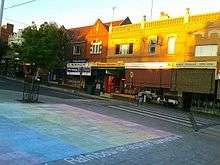
On April 15, 2013, Ashfield Council workers removed the rainbow. After media attention, council issued a statement labelling it a slip hazard and requested a permit be obtained before it could be re-chalked. The events were covered in The Daily Telegraph, The Australian, Perth Now, and on 2DAY FM.
On April 17, 2013, it was rechalked by more than 100 people, including local councillor, Alex Lofts. On April 18, it was again removed, only to be re-chalked. Since that date it has remained chalked. A group of families and supporters continue to chalk the rainbow, especially after rain. This group has also ensured the area remains free of litter; they also hold occasional performances and arts-related celebrations at the site. Some local businesses have offered discounts and support for the rainbow, these display a logo with a stylised image of the rainbow crossing on it.
At an Ashfield Council meeting on 28 May 2013 the council passed a motion that a permanent outline of a rainbow be painted in Summer Hill Square, with the understanding that this may be periodically 'chalked in' by children, families and community members.
The Summer Hill Rainbow Crossing has a following on Twitter, @SummerHillXing, and on Facebook.
See also
References
- ↑ State Heritage Website
- 1 2 3 Australian Bureau of Statistics (27 June 2017). "Summer Hill (State Suburb)". 2016 Census QuickStats. Retrieved 26 July 2017.

- ↑ "Summer Hill boundary map", Geographical Names Board of New South Wales. Retrieved 18 September 2007.
- ↑ Municipality of Ashfield, "C14: Summer Hill Urban Village: Development Control Plan". Retrieved 22 October 2007. Archived 23 July 2008 at the Wayback Machine.
- ↑ "Summer Hill Precinct Heritage review", Ashfield Municipal Council. Retrieved 7 July 2007. Archived 20 July 2008 at the Wayback Machine.
- 1 2 3 4 5 6 7 8 9 Pratten, Chris, Summer Hill. Ashfield & District Historical Society: Australia, 1999. ISBN 0-949842-11-7.
- 1 2 3 4 5 "A Short Walk Through Ashfield's past" booklet, a collaboration between Ashfield Municipal Council and the Ashfield & District Historical Society, circa 1996.
- ↑ "Ashfield Heritage Study Review - Cadigal Reserve", Ashfield Municipal Council. Retrieved 18 September 2007. Archived 25 July 2008 at the Wayback Machine.
- ↑ Doherty, Linda, "Rich and poor of the schools divide", Sydney Morning Herald, 7 November 2003. Retrieved 29 September 2007.
- ↑ "Revealed: Where the money goes", Sydney Morning Herald, 16 March 2004. Retrieved 29 September 2007.
- ↑ Walker, Frank, "Trinity's plans pass despite ticking off locals", Sydney Morning Herald, 11 November 2007. Retrieved 24 October 2009.
- ↑ The Heritage of Australia, Macmillan Company, 1981
- ↑ "Suburb spotlight: Summer Hill", VillageVoice.com.au. Retrieved 26 October 2007. Archived 2 September 2007 at the Wayback Machine.
- 1 2 Munro, Catherine, "Light rail left idling on the track", Sydney Morning Herald, 15 October 2007. Retrieved 15 October 2007.
- ↑ Bozier, Rolfe, "NSWRail.Net: Summer Hill Railway Station". Retrieved 29 September 2007.
- ↑ "Bicycle Paths". Ashfield Municipal Council. Archived from the original on 5 February 2007. Retrieved 7 July 2007.
- ↑ "Canterbury Racecourse AWS". Climate statistics for Australian locations. Bureau of Meteorology. Retrieved 26 July 2017.
- ↑ "2001 Census - Ancestry by Birthplace of Parents: 2130 (Postal Area of Enumeration)". Australian Bureau of Statistics. Retrieved 18 October 2007.
- ↑ http://adb.anu.edu.au/biography/barbour-robert-2931
- ↑ "State Electoral District - Strathfield Results 2003". Elections NSW. Archived from the original on 30 August 2007. Retrieved 7 July 2007. Percentages calculated using combined results for "Summer Hill", "Summer Hill North", and "Summer Hill South" polling booths, and only counting formal votes.
- ↑ "Federal Election 2004 - Summer Hill Polling Booth Results". Australian Electoral Commission. Retrieved 7 July 2007.
- ↑ Constantinou, Menios, "No easy road for M4 East Motorway", Inner West Courier, 10 July 2007. Retrieved 22 October 2007.
- ↑ Nicholls, Sean, "Political poison in airport plan, say councils", Sydney Morning Herald, 20 November 2003. Retrieved 22 October 2007.
- ↑ O'Brien, Geraldine, "'Concrete cowpat' plan stinks: residents", Sydney Morning Herald, 8 October 2002. Retrieved 29 September 2007.
External links
| Wikimedia Commons has media related to Summer Hill, New South Wales. |
- Image of Summer Hill's boundaries, from the Geographical Names Board of New South Wales
- Ashfield & District Historical Society
- Summer Hill Public School
- Trinity Grammar School, located in Summer Hill
- Historic postcards of Summer Hill from the State Library of New South Wales
- St Andrew's Anglican Church
- St Patricks Church
- Summer Hill Community Centre.
- Profile of the federal seat of Grayndler
- Summer Hill Village Business Association
- Demographics for Summer Hill from the Dictionary of Sydney
Coordinates: 33°53′29″S 151°08′18″E / 33.8915°S 151.1382°E